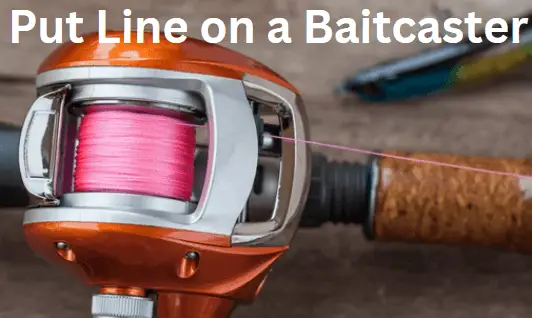To put line on a baitcaster, feed the line through the worm guide, wrap it around the spool, tie an overhand knot around the main line, and finish by tying an overhand knot on the tag end.
Steps For Putting Line On A Baitcaster
Putting line on a baitcaster is a crucial step for any angler. It ensures smooth casting and efficient retrieval, ultimately contributing to a successful fishing experience. Understanding the process of spooling a baitcaster, selecting the right type of fishing line, preparing the baitcasting reel, and properly spooling the line are essential steps that every angler should master. Following these steps will help maintain the integrity of your fishing gear and improve your overall fishing performance.
The Process Of Spooling A Baitcaster
Spooling a baitcaster involves carefully loading the reel with the appropriate fishing line to ensure optimal performance during casting and retrieval. This process demands attention to detail and precision to avoid line tangles and backlash during fishing.
Selecting The Right Type Of Fishing Line
Choosing the right fishing line is crucial for spooling a baitcaster. Different types of fishing lines such as monofilament, fluorocarbon, and braided lines offer distinctive characteristics. Selecting the appropriate line based on the intended fishing conditions and target species is essential for successful spooling.
Preparing The Baitcasting Reel
Prior to spooling, it is important to ensure that the baitcasting reel is clean and in proper working condition. Checking for any damages or irregularities and appropriately lubricating the reel will aid in achieving a smooth and efficient spooling process.
Spooling The Line On The Baitcaster
Properly spooling the line onto the baitcaster involves meticulous threading, knot tying, and spool tension adjustments. This step requires patience and attention to detail to prevent line twists and ensure even distribution on the spool.
Tips For Properly Loading Line On A Baitcaster
- Ensure the line is loaded evenly across the spool to prevent tangles and line twist.
- Adjust the spool tension to match the line being used and minimize backlash during casting.
- Regularly inspect the line for any signs of wear or damage to prevent potential line breakage during fishing.
Common Mistakes To Avoid While Spooling A Baitcaster
When it comes to spooling a baitcaster, there are a few common mistakes that anglers often make. These mistakes can lead to line twists, tangles, overfilling the spool, improper line tension, and even backlash or bird’s nest. By understanding and avoiding these mistakes, you can ensure a smooth and hassle-free spooling process. Let’s take a closer look at these common mistakes and how you can prevent them.
Avoiding Line Twists And Tangles
Line twists and tangles can be frustrating and can significantly affect your casting performance. To avoid these issues, it’s important to properly spool your baitcaster. Here are a few tips:
- Ensure that the line is coming off the filler spool smoothly and not tangling.
- Hold the line tight with your fingers as you begin spooling it onto the reel.
- Make sure the line is evenly distributed on the spool and not overlapping or crossing over itself.
Preventing Line Overfill
Filling the spool to the correct capacity is crucial to avoid line overfill. When the spool is overfilled, it can lead to casting issues and backlash. To prevent line overfill, follow these steps:
- Refer to the manufacturer’s instructions or the reel’s specifications for the recommended line capacity.
- Fill the spool with the appropriate amount of line, leaving some space at the edge of the spool.
- Avoid overfilling the spool, as this can cause the line to get tangled or hinder smooth casting.
Ensuring Proper Line Tension
Having the right line tension is crucial for optimal casting and smooth retrieves. Here are some tips to ensure proper line tension:
- Apply gentle pressure to the line as you spool it onto the reel, maintaining an even tension throughout.
- Avoid pulling the line too tightly, as this can lead to line breakage or the reel not functioning properly.
- Regularly check the tension of the line while spooling to ensure it is not too loose or too tight.
Correcting Spooling Errors
If you have made a mistake while spooling your baitcaster, don’t worry. There are a few ways to correct spooling errors:
If you notice line twists or tangles, stop spooling and carefully untangle the line. You may need to strip some line off the spool and start again.
If you have overfilled the spool, you can remove some line by carefully reeling it off until you reach the desired level.
If you realize that the line tension is incorrect, you can release some tension by letting the line slip through your fingers or by adjusting the drag settings on the reel.
By being aware of these common mistakes and taking the necessary precautions, you can ensure a smooth and successful spooling process for your baitcaster. Avoiding line twists and tangles, preventing line overfill, ensuring proper line tension, and correcting spooling errors will contribute to better casting performance and an overall enjoyable fishing experience.
Types Of Baitcaster Fishing Lines
When it comes to using a baitcaster reel, one of the most important factors to consider is the type of fishing line you choose. Different types of fishing lines offer unique properties and perform differently in various fishing situations. In this article, we will explore the three main types of baitcaster fishing lines: monofilament lines, fluorocarbon lines, and braided lines. We will also discuss important considerations for line weight and application, as well as provide tips for choosing the right line for your baitcaster.
Advanced Techniques For Expertly Loading Line On A Baitcaster
Mastering advanced techniques for loading line on a baitcaster can significantly improve your casting performance and overall angling experience. Let’s delve into some cutting-edge methods that seasoned anglers use to optimize their baitcaster setups.
Using Line-loading Tools And Accessories
Line-loading tools like line spoolers and tensioners can streamline the process and ensure even line distribution on the spool.
Achieving Optimal Line Capacity
Optimal line capacity is crucial for preventing line twists and tangles, enhancing casting distance, and maximizing hooksets.
Fine-tuning Casting Distance And Accuracy
Fine-tuning your baitcaster setup can help you achieve pinpoint accuracy and extended casting distances, giving you a competitive edge on the water.
Utilizing Specialized Knots For Baitcaster Lines
Specialized knots like the double-uni knot or the Alberto knot are ideal for securing braided or fluorocarbon lines on a baitcaster reel.
Experimenting With Backing Materials For Line Setup
Experimenting with backing materials such as monofilament or fluorocarbon can offer additional strength and durability to your baitcaster setup.
Conclusion
After learning the intricacies of putting line on a baitcaster, you are now equipped to spool your reel with confidence. The techniques outlined in this guide will help you avoid common pitfalls and ensure a smooth and hassle-free experience on the water.
With these skills mastered, you can focus on the thrill of fishing without worrying about your equipment.

